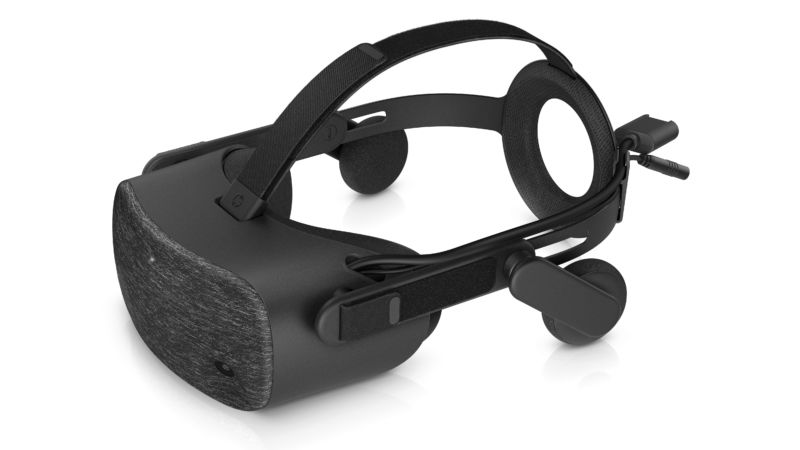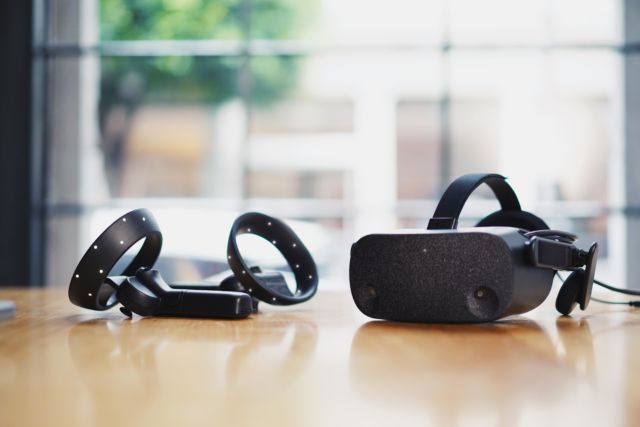
HP was one of the many companies that built a virtual reality headset for the Windows Mixed Reality platform which launched back in 2017. Microsoft provided a SteamVR-compatible software platform, controller design, and inside-out, six-axis, positional-tracking technology; hardware companies like HP provided the rest, greatly reducing the price of PC-attached virtual reality.
Today, HP is launching the Reverb Virtual Reality Headset Professional Edition. As the name might imply, the audience for this isn't the consumer space, it's the commercial space. The headset will have a near-identical consumer version, but HP's focus is very much on the pro unit because that's where the company has seen the most solid uptake of VR tech. The big VR win isn't gaming or any other consumer applications: it's visualization, for fields such as engineering, architecture, education, and entertainment, combining VR headsets with motion-actuated seating to build virtual rides. The company has also found that novelty items such as its VR backpack have also found a role in the corporate space, with companies using them to allow free movement around virtual worlds and objects.
Accordingly, HP's second-gen headset is built for these enterprise customers in mind. Their demands were pretty uniform and in many ways consistent with consumer demands, with the big ones being more resolution and more comfort. To that end, it now has a resolution of 2160×2160 per eye, using an LCD with a 90Hz refresh rate. The optics have also been improved through the use of aspherical lenses, for a 114-degree (diagonal) field of view. AMOLED screens are common in this space, but HP said that it preferred LCD because LCD panels use full red, green, and blue subpixels rather than the pentile arrangement that remains common for AMOLED.
Compared to first-generation headsets—and even the HTC Vive Pro, with its 1440×1600 per eye resolution—there's definitely a discernible improvement in detail and image quality with the Reverb. The extra resolution is particularly compelling when looking at text; readable text was one of the standout features of the Varjo VR1 headset I used recently, and while the HP device doesn't reach those heights, it's still comfortably better than anything else I've used. The company says that this is especially important for education and training software, where even with the joys of virtual reality multimedia, the written word remains important. More generally, the finer detail makes engineering and architectural models look much better.

It's also noticeably more comfortable. I haven't had a chance to use the headset for an extended period, but even in a short demo/hands-on time, it was more comfortable than the Vive Pro that HP also had on hand to compare against. It's also easy to take off and on without too much fuss. As banal as it sounds, comfort is perhaps one of the biggest areas that both virtual and augmented reality headsets will need to improve upon as they become more integrated parts of the workplace and we move from using them for minutes at a time to using them for hours at a time.
Another complaint addressed with the new hardware is Bluetooth connectivity. The motion controllers are Bluetooth devices, and HP found that many desktop PCs have poor Bluetooth implementations, or even no Bluetooth at all. The Reverb puts a Bluetooth controller in the headset itself, so it's always close to the controllers. They even ship pre-paired.
As a nod to the professional role, the face headset's face rest uses a wipe-clean pleather-like material, so that it can quickly be cleaned of sweat between users. This is particularly important for immersive entertainment roles where the headset will be shared by many people over the course of a day.
HP is also producing a consumer-oriented version of the headset; on that, the face rest is fabric coated and can be detached for washing. The Pro version also includes a short headset cable designed to connect it to the HP Z VR Backpack PC; the consumer version doesn't include this. Both include a longer headset cable for attaching to a regular PC, a DisplayPort-to-mini-DisplayPort adaptor, and two motion controllers. Both also have a one-year warranty.
The Professional Edition and Consumer Edition will both become available in late April. The Pro unit will cost $649, and the consumer unit comes in at $599.
https://arstechnica.com/gadgets/2019/03/hp-goes-pro-with-its-newest-vr-headset/Bagikan Berita Ini














0 Response to "Corporations, not consumers, drive demand for HP's new VR headset - Ars Technica"
Post a Comment